Indiana Jones and the Last Crusade
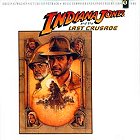 Warner Bros. Records releases John Williams’ soundtrack from Indiana Jones and the Last Crusade.
Warner Bros. Records releases John Williams’ soundtrack from Indiana Jones and the Last Crusade.
 Warner Bros. Records releases John Williams’ soundtrack from Indiana Jones and the Last Crusade.
Warner Bros. Records releases John Williams’ soundtrack from Indiana Jones and the Last Crusade.
 CBS airs the 44th episode of Ron Koslow’s fantasy series Beauty and the Beast, starring Linda Hamilton, Ron Perlman, and Roy Dotrice. Armin Shimerman and Joseph Campanella guest star in the second season finale.
CBS airs the 44th episode of Ron Koslow’s fantasy series Beauty and the Beast, starring Linda Hamilton, Ron Perlman, and Roy Dotrice. Armin Shimerman and Joseph Campanella guest star in the second season finale.
More about Beauty and the Beast in theLogBook.com Store
Beauty & The Beast now streaming on Paramount Plus
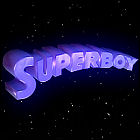 The 26th episode of the syndicated Alexander and Ilya Salkind-produced Superboy series, starring John Haymes Newton and Stacy Haiduk, airs. Newton, Scott Wells and James Calvert makes their final appearances as, respectively, Superboy/Cark, Lex Luthor and T.J. White in the first season finale; both Clark and Luthor are recast for season two.
The 26th episode of the syndicated Alexander and Ilya Salkind-produced Superboy series, starring John Haymes Newton and Stacy Haiduk, airs. Newton, Scott Wells and James Calvert makes their final appearances as, respectively, Superboy/Cark, Lex Luthor and T.J. White in the first season finale; both Clark and Luthor are recast for season two.
This series is not yet chronicled in the LogBook. You could help change that.
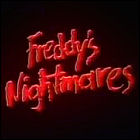 The 22nd episode of the horror anthology series Freddy’s Nightmares is broadcast in syndication in North America, hosted by Robert Englund in character as Freddy Krueger. This episode concludes the series’ first season.
The 22nd episode of the horror anthology series Freddy’s Nightmares is broadcast in syndication in North America, hosted by Robert Englund in character as Freddy Krueger. This episode concludes the series’ first season.
This series is not yet chronicled in the LogBook. You could help change that.
 Geffen Records releases Passion, Peter Gabriel’s soundtrack to the movie The Last Temptation Of Christ. Years later, the producers of the Battlestar Galactica remake miniseries “temp track” early edits of their show with tracks from this album, as a stylistic guide for their music composers.
Geffen Records releases Passion, Peter Gabriel’s soundtrack to the movie The Last Temptation Of Christ. Years later, the producers of the Battlestar Galactica remake miniseries “temp track” early edits of their show with tracks from this album, as a stylistic guide for their music composers.
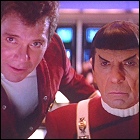 Co-written and directed by William Shatner (whose contract allows him to direct a Star Trek movie since his co-star Leonard Nimoy has done so), Star Trek V: The Final Frontier premieres in theaters to decidedly mixed reviews. This is the first movie featuring the original cast to debut during the run of Star Trek: The Next Generation, and its shaky box office performance ends Harve Bennett’s run as the creative force behind the Star Trek movies.
Co-written and directed by William Shatner (whose contract allows him to direct a Star Trek movie since his co-star Leonard Nimoy has done so), Star Trek V: The Final Frontier premieres in theaters to decidedly mixed reviews. This is the first movie featuring the original cast to debut during the run of Star Trek: The Next Generation, and its shaky box office performance ends Harve Bennett’s run as the creative force behind the Star Trek movies.
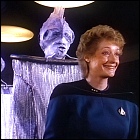 The week-long national syndication window opens for the 44th episode of Star Trek: The Next Generation. Majel Barrett Roddenberry guest stars; Fleetwood Mac drummer Mick Fleetwood appears as a fish (no, really).
The week-long national syndication window opens for the 44th episode of Star Trek: The Next Generation. Majel Barrett Roddenberry guest stars; Fleetwood Mac drummer Mick Fleetwood appears as a fish (no, really).
More about Star Trek: The Next Generation in the LogBook and theLogBook.com Store
Star Trek: The Next Generation now streaming on Paramount Plus
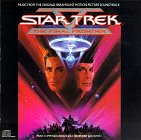
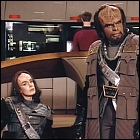 The week-long national syndication window opens for the 45th episode of Star Trek: The Next Generation. Suzie Plakson guest stars.
The week-long national syndication window opens for the 45th episode of Star Trek: The Next Generation. Suzie Plakson guest stars.
More about Star Trek: The Next Generation in the LogBook and theLogBook.com Store
Star Trek: The Next Generation now streaming on Paramount Plus
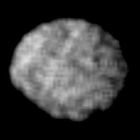 First spotted by Earth-based telescope observations in 1981, Neptune’s fourth-largest natural satellite was so tiny and dark that follow-up observations to confirm the discovery were unsuccessful…at least until Voyager 2 sights it on approach to the eighth planet, finding a tiny moon whose orbit corresponds to the theoretical orbit of the body originally sighted in 1981. In 1991, the International Astronomical Union will name this moon Larissa.
First spotted by Earth-based telescope observations in 1981, Neptune’s fourth-largest natural satellite was so tiny and dark that follow-up observations to confirm the discovery were unsuccessful…at least until Voyager 2 sights it on approach to the eighth planet, finding a tiny moon whose orbit corresponds to the theoretical orbit of the body originally sighted in 1981. In 1991, the International Astronomical Union will name this moon Larissa.
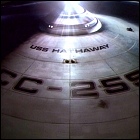 The week-long national syndication window opens for the 46th episode of Star Trek: The Next Generation. Armin Shimerman (Star Trek: DS9) guest stars.
The week-long national syndication window opens for the 46th episode of Star Trek: The Next Generation. Armin Shimerman (Star Trek: DS9) guest stars.
More about Star Trek: The Next Generation in the LogBook and theLogBook.com Store
Star Trek: The Next Generation now streaming on Paramount Plus
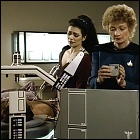 The week-long national syndication window opens for the 47th episode of Star Trek: The Next Generation. Billed as “something Star Trek has never done before” in advance publicity, the second season finale is a clip show made up primarily of “memories” from older episodes – one last blow to the series from the 1988 Writers’ Guild strike. This marks the final appearance of Diana Muldaur as Dr. Katherine Pulaski, as well as the unforgiving (and apparently spine-damaging) uniforms from the first two seasons. This is also the last episode to feature Maurice Hurley as executive producer; he hands the reins over to new executive producer Michael Piller for the third season.
The week-long national syndication window opens for the 47th episode of Star Trek: The Next Generation. Billed as “something Star Trek has never done before” in advance publicity, the second season finale is a clip show made up primarily of “memories” from older episodes – one last blow to the series from the 1988 Writers’ Guild strike. This marks the final appearance of Diana Muldaur as Dr. Katherine Pulaski, as well as the unforgiving (and apparently spine-damaging) uniforms from the first two seasons. This is also the last episode to feature Maurice Hurley as executive producer; he hands the reins over to new executive producer Michael Piller for the third season.
More about Star Trek: The Next Generation in the LogBook and theLogBook.com Store
Star Trek: The Next Generation now streaming on Paramount Plus
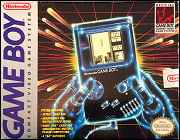 Nintendo launches a portable video game system with interchangeably cartrdiges, the Game Boy, in North America. Though many industry insiders predict a short life for the handheld game thanks to its ability to quickly drain its batteries and its black & white LCD display, the game included with each Game Boy – the incredibly popular puzzle game Tetris – becomes a selling point in itself. With a price tag of around $100, the entire million-unit allotment of Game Boys shipped to American stores sells out in under two months.
Nintendo launches a portable video game system with interchangeably cartrdiges, the Game Boy, in North America. Though many industry insiders predict a short life for the handheld game thanks to its ability to quickly drain its batteries and its black & white LCD display, the game included with each Game Boy – the incredibly popular puzzle game Tetris – becomes a selling point in itself. With a price tag of around $100, the entire million-unit allotment of Game Boys shipped to American stores sells out in under two months.
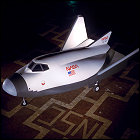 NASA begins intensive work, including the construction of a full-sized test article, on the HL-20, a vehicle being considered for “assured access” to the space station NASA plans to build in the 1990s. HL-20 is based upon the scale-model unmanned BOR4 vehicle test-launched four times by the Soviet Union, and testing will get as far as NASA conducting simulations to determine seating and cargo placement. Despite the relatively recent Challenger disaster, the HL-20 project is quietly dropped in the early 1990s since no urgent need is seen on a widespread basis throughout NASA to phase out or replace the Space Shuttle. The design will be revived in the 21st century by Sierra Nevada Corproation as the proposed Dream Chaser vehicle.
NASA begins intensive work, including the construction of a full-sized test article, on the HL-20, a vehicle being considered for “assured access” to the space station NASA plans to build in the 1990s. HL-20 is based upon the scale-model unmanned BOR4 vehicle test-launched four times by the Soviet Union, and testing will get as far as NASA conducting simulations to determine seating and cargo placement. Despite the relatively recent Challenger disaster, the HL-20 project is quietly dropped in the early 1990s since no urgent need is seen on a widespread basis throughout NASA to phase out or replace the Space Shuttle. The design will be revived in the 21st century by Sierra Nevada Corproation as the proposed Dream Chaser vehicle.
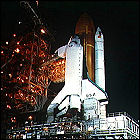 Lifting off on its first spaceflight since January 1986, Space Shuttle Columbia heads into orbit on a five-day classified Department of Defense mission. Columbia’s crew for this flight consists of Commander Brewster Shaw, Pilot Richard Richards, and mission specialists James Adamson, David Leestma and Mark Brown.
Lifting off on its first spaceflight since January 1986, Space Shuttle Columbia heads into orbit on a five-day classified Department of Defense mission. Columbia’s crew for this flight consists of Commander Brewster Shaw, Pilot Richard Richards, and mission specialists James Adamson, David Leestma and Mark Brown.
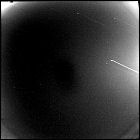 NASA announces the confirmation of what are believed to be partial rings around planet Neptune, as discovered in images taken by the unmanned Voyager 2 space probe. The ring arcs are found in close proximity to several new satellites, also spotted in Voyager 2 images, which are too small to have been seen form Earth-based telescopes. Ground-based telescopes had led scientists to believe that they would find partial rings, or complete dark rings, at Neptune; at this time, however, and at a distance of 13 million miles, what the project scientists don’t expect is that the rings will be revealed to completely encircle the planet within mere weeks.
NASA announces the confirmation of what are believed to be partial rings around planet Neptune, as discovered in images taken by the unmanned Voyager 2 space probe. The ring arcs are found in close proximity to several new satellites, also spotted in Voyager 2 images, which are too small to have been seen form Earth-based telescopes. Ground-based telescopes had led scientists to believe that they would find partial rings, or complete dark rings, at Neptune; at this time, however, and at a distance of 13 million miles, what the project scientists don’t expect is that the rings will be revealed to completely encircle the planet within mere weeks.
 CBS airs the pilot movie Nick Knight, starring Rick Springfield and John Kapelos, involving a police detective who lives a double life as a vampire. Though Nick Knight does not immediately lead to a series, the concept will be reworked (and largely recast, with only Kapelos appearing in both versions) as Forever Knight in 1992, which will run for three seasons.
CBS airs the pilot movie Nick Knight, starring Rick Springfield and John Kapelos, involving a police detective who lives a double life as a vampire. Though Nick Knight does not immediately lead to a series, the concept will be reworked (and largely recast, with only Kapelos appearing in both versions) as Forever Knight in 1992, which will run for three seasons.
More about Forever Knight in theLogBook.com Store
Forever Knight now streaming on Amazon Prime
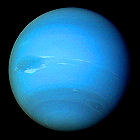 The unmanned space probe Voyager 2, almost exactly 12 years after leaving Earth, visits its last planet in the solar system, Neptune. Since mission planners have no further targets for Voyager, they have a free hand in picking its final destinations. An extremely close trajectory over Neptune’s north pole, bringing Voyager 2 within 18,000 miles of the cloudtops of the solar system’s windiest planet, deflects Voyager downward behind Neptune for a close look at its large moon, Triton. Six new moons are discovered, and the “ring arcs” that astronomers have theorized for years turn out to be complete rings made of extremely dark material. After the surprisingly featureless face of Uranus, Neptune proves to be unexpectedly active, with a large dark storm dominating its atmosphere.
The unmanned space probe Voyager 2, almost exactly 12 years after leaving Earth, visits its last planet in the solar system, Neptune. Since mission planners have no further targets for Voyager, they have a free hand in picking its final destinations. An extremely close trajectory over Neptune’s north pole, bringing Voyager 2 within 18,000 miles of the cloudtops of the solar system’s windiest planet, deflects Voyager downward behind Neptune for a close look at its large moon, Triton. Six new moons are discovered, and the “ring arcs” that astronomers have theorized for years turn out to be complete rings made of extremely dark material. After the surprisingly featureless face of Uranus, Neptune proves to be unexpectedly active, with a large dark storm dominating its atmosphere.
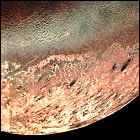 As scientists marvel over the latest data and pictures from Voyager 2 as it leaves Neptune, images of the planet’s large moon Triton prove to be jaw-dropping. Active geysers blast dark material – possibly evidence of cryovolcanism – over the moon’s mottled surface, and an atmosphere is measured. Virtually no craters caused by meteor impacts are spotted, meaning that Triton’s surface is geologically active – all completely new discoveries to Earth-based scientists. Perhaps the most frustrating part of all of the new information is that no further missions to Neptune are in serious consideration by NASA to follow up on Voyager 2’s discoveries.
As scientists marvel over the latest data and pictures from Voyager 2 as it leaves Neptune, images of the planet’s large moon Triton prove to be jaw-dropping. Active geysers blast dark material – possibly evidence of cryovolcanism – over the moon’s mottled surface, and an atmosphere is measured. Virtually no craters caused by meteor impacts are spotted, meaning that Triton’s surface is geologically active – all completely new discoveries to Earth-based scientists. Perhaps the most frustrating part of all of the new information is that no further missions to Neptune are in serious consideration by NASA to follow up on Voyager 2’s discoveries.
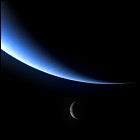 NASA’s unmanned Voyager 2 space probe leaves the vicinity of the planet Neptune, the outermost planet to have been explored by a man-made spacecraft. (At this point in time, Pluto is still considered a planet – the only one to which NASA hasn’t sent a space probe – though by the time a vehicle is dispatched to Pluto in the 21st century, Pluto has been demoted to “minor planet” status.) Though not expected to function beyond 2025 due to the slow decay of its nuclear power source, Voyager 2 may survive long enough to pass within 25,000,000,000,000 miles of Sirius in a quarter of a million years.
NASA’s unmanned Voyager 2 space probe leaves the vicinity of the planet Neptune, the outermost planet to have been explored by a man-made spacecraft. (At this point in time, Pluto is still considered a planet – the only one to which NASA hasn’t sent a space probe – though by the time a vehicle is dispatched to Pluto in the 21st century, Pluto has been demoted to “minor planet” status.) Though not expected to function beyond 2025 due to the slow decay of its nuclear power source, Voyager 2 may survive long enough to pass within 25,000,000,000,000 miles of Sirius in a quarter of a million years.
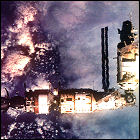 Cosmonauts Alexander Viktorenko and Aleksandr Serebrov lift off aboard the Soviet spacecraft Soyuz TM-8, bound for the presently unoccupied space station Mir (which had been left without a crew since April 1989). At a distance of only 4 meters to Mir’s docking hatch, Soyuz TM-8 suffers a breakdown of its automated docking system, and Viktorenko has no choice but to back the Soyuz away and carefully dock under manual control. The two-man crew remains aboard Mir for 166 days, returning to Earth in February 1990.
Cosmonauts Alexander Viktorenko and Aleksandr Serebrov lift off aboard the Soviet spacecraft Soyuz TM-8, bound for the presently unoccupied space station Mir (which had been left without a crew since April 1989). At a distance of only 4 meters to Mir’s docking hatch, Soyuz TM-8 suffers a breakdown of its automated docking system, and Viktorenko has no choice but to back the Soyuz away and carefully dock under manual control. The two-man crew remains aboard Mir for 166 days, returning to Earth in February 1990.
 The 684th episode of Doctor Who airs on BBC1. Jean Marsh guest stars, and Nicholas Courtney makes his final original series appearance as Brigadier Lethbridge-Stewart. This story opens the 26th and final season of the original Doctor Who series.
The 684th episode of Doctor Who airs on BBC1. Jean Marsh guest stars, and Nicholas Courtney makes his final original series appearance as Brigadier Lethbridge-Stewart. This story opens the 26th and final season of the original Doctor Who series.
More about Doctor Who in the LogBook
Order VWORP!1 from theLogBook.com Store
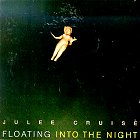 Julee Cruise‘s debut album Floating Into The Night is released on Warner Bros. Records, placating fans of the surprise hit TV series Twin Peaks (Cruise sings the show’s theme song). With lyrics by Twin Peaks auteur David Lynch and music by the show’s resident composer, Angelo Badalamenti, the album is strongly reminiscent of the series’ music; a proper Twin Peaks soundtrack album follows almost exactly a year later.
Julee Cruise‘s debut album Floating Into The Night is released on Warner Bros. Records, placating fans of the surprise hit TV series Twin Peaks (Cruise sings the show’s theme song). With lyrics by Twin Peaks auteur David Lynch and music by the show’s resident composer, Angelo Badalamenti, the album is strongly reminiscent of the series’ music; a proper Twin Peaks soundtrack album follows almost exactly a year later.
 The 685th episode of Doctor Who airs on BBC1. Jean Marsh guest stars, and Nicholas Courtney makes his final original series appearance as Brigadier Lethbridge-Stewart. This story opens the 26th and final season of the original Doctor Who series.
The 685th episode of Doctor Who airs on BBC1. Jean Marsh guest stars, and Nicholas Courtney makes his final original series appearance as Brigadier Lethbridge-Stewart. This story opens the 26th and final season of the original Doctor Who series.
More about Doctor Who in the LogBook
Order VWORP!1 from theLogBook.com Store
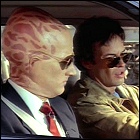 The recently-launched Fox Network launches its first prime-time science fiction series, Kenneth Johnson’s TV adaptation of the movie Alien Nation. Gary Graham, Eric Pierpoint and Michele Scarabelli star in a story of escaped alien slaves who inadvertently land on Earth, becoming a somewhat marginalized immigrant population. Diane Civita (V) and Tim Russ (Star Trek: Voyager) guest star in the pilot.
The recently-launched Fox Network launches its first prime-time science fiction series, Kenneth Johnson’s TV adaptation of the movie Alien Nation. Gary Graham, Eric Pierpoint and Michele Scarabelli star in a story of escaped alien slaves who inadvertently land on Earth, becoming a somewhat marginalized immigrant population. Diane Civita (V) and Tim Russ (Star Trek: Voyager) guest star in the pilot.
More about Alien Nation in the LogBook and theLogBook.com Store
Alien Nation now streaming on Amazon Prime
 NBC airs the ninth episode of Donald Bellisario’s science fiction series Quantum Leap, starring Scott Bakula and Dean Stockwell. Alice Adair guest stars in the second season premiere.
NBC airs the ninth episode of Donald Bellisario’s science fiction series Quantum Leap, starring Scott Bakula and Dean Stockwell. Alice Adair guest stars in the second season premiere.
This series is not yet fully chronicled in the LogBook. You could help change that.
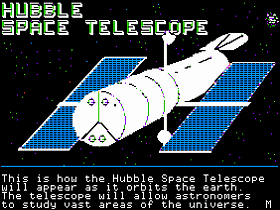 NASA releases an interactive electronic educational guide to the upcoming Hubble Space Telescope for the Apple II computer. Featuring diagrams of the orbiting telescope’s construction, methods of communication with Earth, and how it gathers its images. The software is released ahead of HST’s launch aboard an upcoming shuttle flight.
NASA releases an interactive electronic educational guide to the upcoming Hubble Space Telescope for the Apple II computer. Featuring diagrams of the orbiting telescope’s construction, methods of communication with Earth, and how it gathers its images. The software is released ahead of HST’s launch aboard an upcoming shuttle flight.
 The 686th episode of Doctor Who airs on BBC1. Jean Marsh guest stars, and Nicholas Courtney makes his final original series appearance as Brigadier Lethbridge-Stewart. This story opens the 26th and final season of the original Doctor Who series.
The 686th episode of Doctor Who airs on BBC1. Jean Marsh guest stars, and Nicholas Courtney makes his final original series appearance as Brigadier Lethbridge-Stewart. This story opens the 26th and final season of the original Doctor Who series.
More about Doctor Who in the LogBook
Order VWORP!1 from theLogBook.com Store
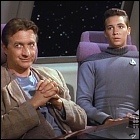 The week-long national syndication window opens for the 48th episode of Star Trek: The Next Generation, opening the third season. Ken Jenkins (Scrubs) and Whoopi Goldberg guest star.
The week-long national syndication window opens for the 48th episode of Star Trek: The Next Generation, opening the third season. Ken Jenkins (Scrubs) and Whoopi Goldberg guest star.
More about Star Trek: The Next Generation in the LogBook and theLogBook.com Store
Star Trek: The Next Generation now streaming on Paramount Plus
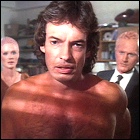 Fox Network premieres the second episode of Alien Nation. Susan Gibney guest stars.
Fox Network premieres the second episode of Alien Nation. Susan Gibney guest stars.
More about Alien Nation in the LogBook and theLogBook.com Store
Alien Nation now streaming on Amazon Prime